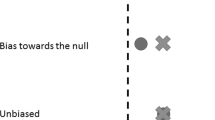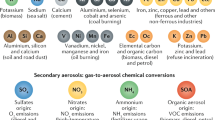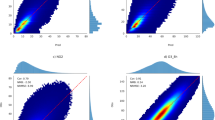Abstract
Examining the validity of exposure metrics used in air pollution epidemiologic models has been a key focus of recent exposure assessment studies. The objective of this work has been, largely, to determine what a given exposure metric represents and to quantify and reduce any potential errors resulting from using these metrics in lieu of true exposure measurements. The current manuscript summarizes the presentations of the co-authors from a recent EPA workshop, held in December 2006, dealing with the role and contributions of exposure assessment in addressing these issues. Results are presented from US and Canadian exposure and pollutant measurement studies as well as theoretical simulations to investigate what both particulate and gaseous pollutant concentrations represent and the potential errors resulting from their use in air pollution epidemiologic studies. Quantifying the association between ambient pollutant concentrations and corresponding personal exposures has led to the concept of defining attenuation factors, or α. Specifically, characterizing pollutant-specific estimates for α was shown to be useful in developing regression calibration methods involving PM epidemiologic risk estimates. For some gaseous pollutants such as NO2 and SO2, the associations between ambient concentrations and personal exposures were shown to be complex and still poorly understood. Results from recent panel studies suggest that ambient NO2 measurements may, in some locations, be serving as surrogates to traffic pollutants, including traffic-related PM2.5, hopanes, steranes, and oxidized nitrogen compounds (rather than NO2).
This is a preview of subscription content, access via your institution
Access options
Subscribe to this journal
Receive 6 print issues and online access
$259.00 per year
only $43.17 per issue
Buy this article
- Purchase on Springer Link
- Instant access to full article PDF
Prices may be subject to local taxes which are calculated during checkout





Similar content being viewed by others
References
Adar S.D., Gold D.R., Coull B.A., Schwartz J., Stone P.H., and Suh H. Focused exposures to airborne traffic particles and heart rate variability in the elderly. Epidemiology 2007: 18: 95–103.
Alm S., Mukala K., Pasanen P., Tiittanen P., Ruuskanen J., Tuomisto J., and Jantunen M.J. Personal NO2 exposures of preschool children in Helsinki. J Exposure Anal Environ Epidemiol 1998: 8: 79–100.
Brook J.R., Graham L., Charland J.P., Cheng Y., Fan X., Lu G., Li S.M., Lillyman C., MacDonald P., Caravaggio G., and MacPhee J.A. Investigation of the motor vehicle exhaust contribution to primary fine particle organic carbon in urban air. Atmos Environ 2007: 41: 119–135.
Brunekreef B., Janssen N., De Hartog J., Oldenwening M., Meliefste K., Hoek G., Lanki T., Timonen K., Vallius M., Pekkanen J., and Van Grieken R. Personal Indoor and Outdoor Exposures to PM2.5 and its Components for Groups of Cardiovascular Patients in Amsterdam and Helsinki 2005, Health Effects Institute, Boston; Research report no. 127. Available at http://pubs.healtheffects.org/types.php?type=1(30 March 2007).
Burnett R.T., and Goldberg M.S. Size-fractionated particulate mass and daily mortality in eight Canadian cities. In: Revised Analyses of Time-Series Studies of Air Pollution and Health. Special Report 2003, Health Effects Institute, Boston, pp 85–89 Available at http://www.healtheffects.org/news.htm(16 May 2003).
Burnett R.T., Stieb D., Brook J.R., Cakmak S., Dales R., Raizenne M., Vincent R., and Dann T. Associations between short-term changes in nitrogen dioxide and mortality in Canadian cities. Arch Environ Health 2004: 59: 228–236.
Carroll R.J., Ruppert D., and Stefanski L.A. Measurement error in nonlinear models, Cox D.R., Hinkley D.V., Keiding N., Reid N., Rubin D.B., and Silverman B.W. (Eds.) Monographs on Statistics and Applied Probability 1995, Chapman & Hall, London, . vol. 63.
Dominici F., Zeger S.L., and Samet J.M. A measurement error model for time-series studies of air pollution and mortality. Biostatistics 2000: 1: 157–175.
Ebelt S.T., Petkau A.J., Vedal S., Fisher T.V., and Brauer M. Exposure of chronic obstructive pulmonary disease patients to particulate matter: relationships between personal and ambient air concentrations. J Air Waste Manage Assoc 2000: 50: 1081–1094.
Ebelt S.T., Wilson W.E., and Brauer M. Exposure to ambient and nonambient components of particulate matter: a comparison of health effects. Epidemiology 2005: 16: 396–405.
Janssen N.A.H., De Hartog J.J., Hoek G., Brunekreef B., Lanki T., Timonen K.L., and Pekkanen J. Personal exposure to fine particulate matter in elderly subjects: relation between personal indoor and outdoor concentrations. J Air Waste Manage Assoc 2000: 50: 1133–1143.
Janssen N.A.H., Hoek G., Harssema H., and Brunekreef B. Childhood exposure to PM10: relation between personal classroom and outdoor concentrations. Occup Environ Med 1997: 54: 888–894.
Kim D., Sass-Kortsak A., Purdham J.T., Dales R.E., and Brook J.R. Associations between personal exposures and fixed-site ambient measurements of fine particulate matter nitrogen dioxide and carbon monoxide in Toronto, Canada. J Exposure Sci Environ Epidemiol 2006: 16: 172–183.
Koenig J.Q., Mar T.F., Allen R.W., Jansen K., Lumley T., Sullivan J.H., Trenga C.A., Larson T., and Liu L.J. Pulmonary effects of indoor- and outdoor-generated particles in children with asthma. Environ Health Perspect 2005: 113: 499–503.
Koutrakis P., Suh H.H., Sarnat J.A., Brown K.W., Coull B.A., and Schwartz J. Characterization of Particulate and Gas Exposures of Sensitive Populations Living in Baltimore and Boston 2005, Health Effects Institute, Boston, Research report no. 131.
Liard R., Zureik M., Le Moullec Y., Soussan D., Glorian M., Grimfeld A., and Neukirch F. Use of personal passive samplers for measurement of NO2 NO and O3 levels in panel studies. Environ Res 1999: 81: 339–348.
Liu L.-J., Box M., Kalman D., Kaufman J., Koenig J., Larson T., Lumley T., Sheppard L., and Wallace L. Exposure assessment of particulate matter for susceptible populations in Seattle. Environ Health Perspect 2003: 11: 909–918.
Mage D., Wilson W., Hasselblad V., and Grant L. Assessment of human exposure to ambient particulate matter. J Air Waste Manage Assoc 1999: 49: 1280–1291.
Meng Q.Y., Turpin B.J., Polidori A., Lee J.H., Weisel C., Morandi M., Colome S., Stock T., Winer A., and Zhang J. PM2.5 of ambient origin: estimates and exposure errors relevant to PM epidemiology. Environ Sci Technol 2005: 39: 5105–5112.
Ott W., Wallace L., and Mage D. Predicting particulate (PM10) personal exposure distributions using a random component superposition statistical model. J Air Waste Manage Assoc 2000: 50: 1390–1406.
Ozkaynak H., Xue J., Spengler J., Wallace L., Pellizzari E., and Jenkins P. Personal exposures to airborne particles and metals: results from the particle TEAM study in Riverside California. J Exposure Anal Environ Epidemiol 1996: 6: 57–78.
Rabinovitch N., Strand M., and Gelfand E.W. Particulate levels are associated with early asthma worsening in children with persistent disease. Am J Respir Crit Care Med 2006: 173: 1098–1105.
Sarnat J.A., Brown K.W., Schwartz J., Coull B.A., and Koutrakis P. Ambient gas concentrations and personal particulate matter exposures: implications for studying the health effects of particles. Epidemiology 2005: 16: 385–395.
Sarnat J.A., Koutrakis P., and Suh H.H. Assessing the relationship between personal particulate and gaseous exposures of senior citizens living in Baltimore, MD. J Air Waste Manage Assoc 2000: 50: 1184–1198.
Sarnat J.A., Long C.M., Koutrakis P., Coull B.A., Schwartz J., and Suh H.H. Using sulfur as a tracer of outdoor fine particulate matter. Environ Sci Technol 2002: 36: 5305–5314.
Sarnat J.A., Schwartz J., Catalano P.J., and Suh H.H. Gaseous pollutants in particulate matter epidemiology: confounders or surrogates? Environ Health Perspect 2001: 109: 1053–1061.
Sarnat S.E., Suh H.H., Coull B.A., Schwartz J., Stone P.H., and Gold D.R. Ambient particulate air pollution and cardiac arrhythmia in a panel of older adults in Steubenville Ohio. Occup Environ Med 2006: 63: 700–706.
Sheppard L., Slaughter J.C., Schildcrout J., Liu L.-J.S., and Lumley T. Exposure and measurement contributions to estimates of acute air pollution effects. J Exposure Anal Environ Epidemiol 2005: 15: 366–376.
Strand M., Vedal S., Rodes C., Dutton S.J., Gelfand E.W., and Rabinovitch N. Estimating effects of ambient PM2.5 exposure on health using PM2.5 component measurements and regression calibration. J Exposure Sci Environ Epidemiol 2006: 16: 30–38.
Suh H., and Zanobetti A. Impact of exposure error on the relationship between traffic-related air pollution and heart rate variability (HRV). Epidemiology 2006: 17: S213.
Wade K.S., Mulholland J.A., Marmur A., Russell A.G., Hartsell B., Edgerton E., Klein M., Waller L., Peel J.L., and Tolbert P.E. Effects of instrument precision and spatial variability on the assessment of the temporal variation of ambient air pollution in Atlanta, Georgia. J Air Waste Manage Assoc 2006: 56: 876–888.
Wheeler A., Zanobetti A., Gold D.R., Schwartz J., Stone P., and Suh H.H. The relationship between ambient air pollution and heart rate variability differs for individuals with heart and pulmonary disease. Environ Health Perspect 2006: 114: 560–566.
Williams R., Suggs J., Creason J., Rodes C., Lawless P., Kwok R., Zweidinger R., and Sheldon L. The 1998 Baltimore Particulate Matter Epidemiology-Exposure Study: part 2. Personal exposure assessment associated with an elderly study population. J Exposure Anal Environ Epidemiol 2000: 10: 533–543.
Wilson W.E., and Brauer M. Estimation of ambient and non-ambient components of particulate matter exposure from a personal monitoring panel study. J Exposure Sci Environ Epidemiol 2006: 16: 264–274.
Wilson W.E., and Brauer M. Methods to estimate the ambient and nonambient components of total personal exposure to particulate matter. In: Abstracts from Conference of the International Society of Exposure Assessment, November. Charleston, SC, 2001.
Wilson W.E., Mage D.T., and Grant L.D. Estimating separately personal exposure to ambient and nonambient particulate matter for epidemiology and risk assessment: why and how? J Air Waste Manage Assoc 2000: 50: 1167–1183.
Zeger S.L., Thomas D., Dominici F., Samet J.M., Schwartz J., Dockery D., and Cohen A. Exposure measurement error in time-series studies of air pollution: concepts and consequences. Environ Health Perspect 2000: 108: 419–426.
Acknowledgements
Analyses from the Harvard field studies, which were presented as part of this workshop session, were conducted with data collected by numerous investigators. We gratefully acknowledge the generosity of the following individuals in sharing the data they collected and processed: Kathleen Ward Brown (Harvard School of Public Health), Stefanie E. Sarnat (Rollins School of Public Health of Emory University), Amanda Wheeler (Health Canada), Petros Koutrakis (Harvard School of Public Health), and Helen Suh (Harvard School of Public Health). Dr. Sarnat was funded by the US Environmental Protection Agency (Contract no. EP07C000040) for his work in preparing this manuscript.
Author information
Authors and Affiliations
Corresponding author
Additional information
Disclaimer
This article has been reviewed by the National Center for Environmental Assessment, US Environmental Protection Agency, and approved for publication. Approval does not signify that the contents necessarily reflect the views and policies of the Agency.
Rights and permissions
About this article
Cite this article
Sarnat, J., Wilson, W., Strand, M. et al. Panel discussion review: session 1 — exposure assessment and related errors in air pollution epidemiologic studies. J Expo Sci Environ Epidemiol 17 (Suppl 2), S75–S82 (2007). https://doi.org/10.1038/sj.jes.7500621
Received:
Accepted:
Published:
Issue Date:
DOI: https://doi.org/10.1038/sj.jes.7500621
Keywords
This article is cited by
-
Exposure measurement error and the characterization of child exposure to fecal contamination in drinking water
npj Clean Water (2020)
-
Estimating ambient-origin PM2.5 exposure for epidemiology: observations, prediction, and validation using personal sampling in the Multi-Ethnic Study of Atherosclerosis
Journal of Exposure Science & Environmental Epidemiology (2019)
-
Exposure measurement error in PM2.5 health effects studies: A pooled analysis of eight personal exposure validation studies
Environmental Health (2014)
-
Time series analysis of personal exposure to ambient air pollution and mortality using an exposure simulator
Journal of Exposure Science & Environmental Epidemiology (2012)
-
Impact of exposure measurement error in air pollution epidemiology: effect of error type in time-series studies
Environmental Health (2011)



